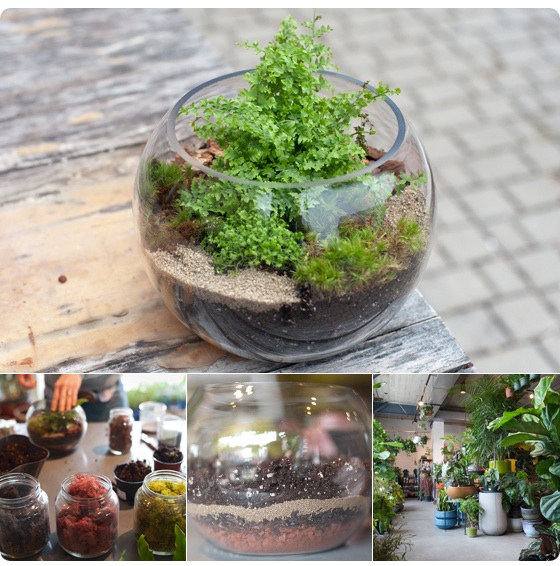
Tara Heibel, founder of
Sprout Home in Ukranian Village, uses terrariums to help her customers add a touch of green to their concrete-colored city lives. The “miniature garden on a table” is a possible answer for those with busy schedules, since the plants inside the self-contained orbs generally need less frequent watering than they would in the open air. The contents aren’t limited to just greenery either: Heibel compares the terrarium to an “imaginary world” that kids and adults can playfully augment with plastic figurines such as dinosaurs or fairies.
But while the terrarium is playful at heart, designing and maintaining one isn’t always kids’ stuff. Navigating factors such as drainage, soil type, sunlight, and watering can seem intimidating for the uninitiated. Here, Heibel covers a few of the basics to get beginner terrarium-builders off to a good start.
GROUPON: In what order should terrarium ingredients be placed? Do you have a standard aesthetic approach for arranging your plants?
TARA HEIBEL: Rocks in the bottom, [then] potting medium, charcoal (for filtering harmful minerals and absorbing odors), and then, of course, plants. I make sure there’s some kind of ground cover...and then [place plants at] varying degrees of height.
G: What’s a user-friendly plant lineup for first-time terrariums?
TH: If you’re pairing plants together they’re sharing the same soil, the same light, and the same watering, so [you] have to pick plants that play nicely together. If [the terrarium is in] direct sun, easy plants to use would be various forms of succulents, not only because they can handle the light, but [because] they can dry out between waterings, and they have a shorter root system. For [an environment with] low light...I like humidity lovers: mosses and ferns.
G: If plants start to look unhealthy, how can beginners identify and fix the underlying problem?
TH: If plants start to turn a little yellow or jaundiced-looking, it’s generally from over-watering. If a plant starts to get brown tips at the edge of the leaf [that] start to work inward, that usually [indicates] under-watering or too much sun. If you’re getting anything black and fuzzy, you have a fungus going on in your terrarium, and you [might need to] do a bleach solution or a vinegar solution to really clean [it] out, and then you have to re-pot it.
G: What, in your experience, is the beginning terrarium-tender’s most common mistake?
TH: The disadvantage of the terrarium is it doesn’t have a drain hole, so you do have to pay attention to what you’re doing so you don’t over-flood them. If [the terrarium vessel] is clear, then you have an advantage, so that you can see those layers that are underneath and kind of have a little bit more control over your watering techniques.
G: Do you have any final words of wisdom for beginning terrarium-owners?
TH: You look at a plant inside a flower shop and you think, that plant would look so good in a terrarium. But a lot of people don’t realize that that plant grows. So you have to have a little bit of a bonsai enthusiast in you...You have to make sure that you’re cool with maintenance.






 Tara Heibel, founder of
Tara Heibel, founder of 
